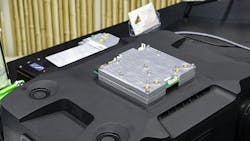See What Can't Be Seen
This video is part of the TechXchange: Vector Network Analyzers.
Copper Mountain Technologies, known primarily for its desktop vector network analyzers (VNAs), doesn't limit itself in terms of packaging and deployment. To that end, Brian Walker, CMT's Senior RF Engineer, recently showed me a demo of a 5.5-GHz VNA in modular form (see figure). Were it to be imaginatively deployed, this little 2-port VNA could serve a plethora of applications from agricultural to infrastructure inspection and maintenance.
Copper Mountain Technologies can build custom VNAs in such compact formats as well as rack-mount units or analyzers in special sizes to fit a system requirement. Such devices use an external computer for data processing and analysis, storage, and software integration with other systems. The company can also create purpose-built software for Windows or Linux operating systems that integrates the VNA with other system components.
Here's a transcript of the video (it has been edited for clarity):
What I’d like to show you today is this 5.5-GHz VNA. It’s a two-port VNA, a little module. And I believe it to be the smallest metrologically sound VNA in the world. This is meant to be a bolt-in.
We’ve been selling, of course, desktop VNAs for some time, but this is disruptive. This is meant to go into a larger system that perhaps does imaging. Maybe it measures agricultural products, maybe it measures soil moisture. The applications are endless and that’s up to our customers to find those applications while we supply this superior product for their use.
Here’s a demonstration of what this little product can do:
We built it into a little cart, which has a positional encoder, so it knows the location of the cart. Inside the cart is this 5.5-GHz VNA and a pair of antennas in the front. It does a time-domain measurement through the surface of this table, and under it is an aluminum target. As we move the cart along the table, we’re going to be able to see the penetration plot on the screen as it goes.
As I move the cart, you see the different reflections through the surface of the table. Eventually I’m going to get to the aluminum target, and there it is. Now it’s a little hard to see this, but I can change the gain. I can stretch this out. But what we’re really looking for is this small perturbation in the measurement. That indicates that it’s seeing a strong reflection from the bottom side of the table.
Now, we might be going a lot farther down. We might be imaging through concrete, looking at water ingress into the concrete, or maybe we’re looking at the rebar strengthening members inside the concrete. This could be used for something like that. But we sell this module for this kind of application.
No one else is doing anything like this. This VNA is meant to go into a larger system, much like the radio modem in your cell phone enables voice calls. But how often do we talk to people on our phones anymore? This will be part of a bigger system for doing important things.
Read more articles in the TechXchange: Vector Network Analyzers.
About the Author
David Maliniak
Executive Editor, Microwaves & RF
I am Executive Editor of Microwaves & RF, an all-digital publication that broadly covers all aspects of wireless communications. More particularly, we're keeping a close eye on technologies in the consumer-oriented 5G, 6G, IoT, M2M, and V2X markets, in which much of the wireless market's growth will occur in this decade and beyond. I work with a great team of editors to provide engineers, developers, and technical managers with interesting and useful articles and videos on a regular basis. Check out our free newsletters to see the latest content.
You can send press releases for new products for possible coverage on the website. I am also interested in receiving contributed articles for publishing on our website. Use our contributor's packet, in which you'll find an article template and lots more useful information on how to properly prepare content for us, and send to me along with a signed release form.
About me:
In his long career in the B2B electronics-industry media, David Maliniak has held editorial roles as both generalist and specialist. As Components Editor and, later, as Editor in Chief of EE Product News, David gained breadth of experience in covering the industry at large. In serving as EDA/Test and Measurement Technology Editor at Electronic Design, he developed deep insight into those complex areas of technology. Most recently, David worked in technical marketing communications at Teledyne LeCroy, leaving to rejoin the EOEM B2B publishing world in January 2020. David earned a B.A. in journalism at New York University.

